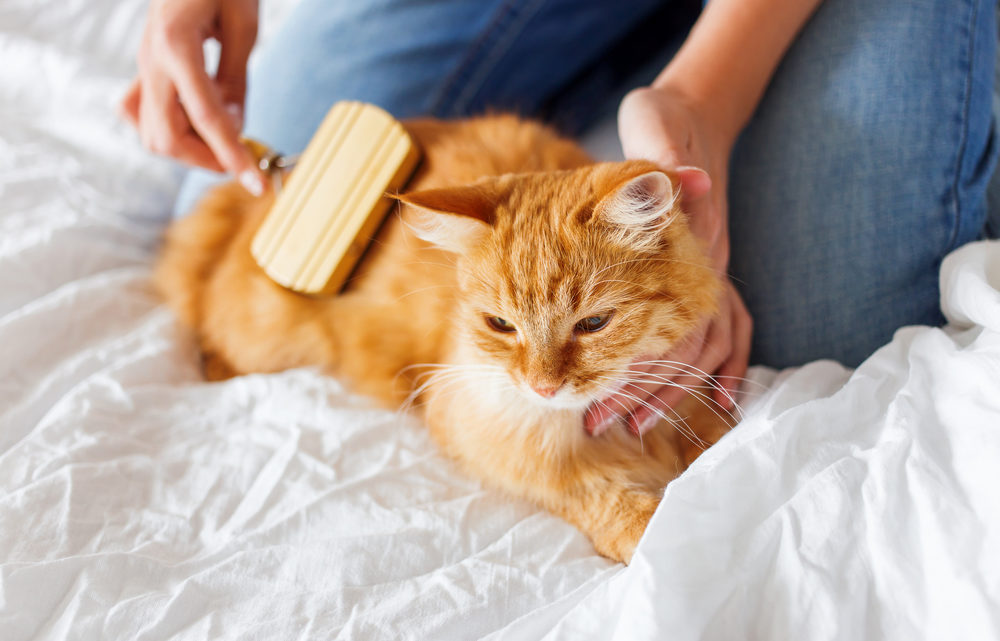Most cats do a superb job of grooming themselves, but sometimes they need a bit of assistance.
You’ve probably noticed that your cat spends a lot of time washing himself. Felines are fastidious by nature, and regular grooming is important to them. But sometimes they need a helping hand, especially if they’re aging, or have longer fur that tends to get matted. Following these tips will help you complement your kitty’s grooming routine and ensure a sleek, contented cat.
Brushing and combing
Some cats love being groomed, but others will slink away as soon as the grooming tools appear. One way to help your cat accept some extra grooming is to use the right equipment. Avoid stiff-bristled brushes that may scratch his skin. Some pet combs are made of metal, so if this is what you have, be gentle, and use the comb on an angle to the cat’s skin, so the teeth don’t poke him.
Start your grooming sessions with a wide-toothed comb. This will help remove dead undercoat and other debris. Follow up with brushing, using a soft-bristled brush, or a pin brush with ball-tipped pins. Be gentle, and don’t press too hard. Many cats prefer brushing to combing, as it feels more like a massage!
You can also use a grooming glove, which features soft plastic bumps or tips specifically designed for removing loose fur. This might be a good alternative for cats who don’t like combs and brushes. A grooming glove closely mimics a stroking hand, and can feel more acceptable to the cat.
What to do about mats
If your cat’s coat is long and prone to matting, you’ll need to take some extra time with his grooming. Daily combing and brushing can help prevent mats in the first place, but once a mat has formed, you’ll need to help your cat get rid of it.
Start by trying to gently untangle the mat with a comb. Pulling at it is painful for the cat, so if a comb isn’t doing the trick, you may have to clip the mat out. This can be a tricky procedure, especially if your cat is jumpy. It’s best to have a helper hold the cat while you’re working. Use blunt-nosed scissors or clippers, take your time, and make sure you’re not getting too close to his skin. If you don’t feel comfortable removing the mat yourself, ask your vet or groomer to do it.
Depending on your cat, you may need to at least brush him every day or two, although a once-weekly grooming session will be adequate for most kitties. Keep an eye on how well your cat is grooming himself, and give him some assistance when needed to help keep his coat and skin in good health.
Bath time!
Even the most laidback cat usually doesn’t enjoy having a bath, but you can make it less stressful with the right approach.
- Choose a gentle, natural shampoo formulated specifically for cats. Avoid artificial fragrances.
- A sink at waist level is best. Bending over a bathtub is hard on the back.
- Put a towel on the bottom of the sink. Your cat will feel more comfortable if his feet aren’t sliding around on slippery surfaces.
- You can wet and rinse the cat with a pitcher, or use a hand spray, but keep water and shampoo away from his face. Be sure to use only lukewarm water.
- Stay calm and praise your cat. Getting upset because he’s anxious will only stress him more.
- Soak up the moisture from his coat with a warm soft towel, then let him air dry the rest of the way. Don’t use a hair dryer – it’s too hot, and the noise may scare him.
If your cat hates being groomed
It’s best to introduce your cat to regular grooming sessions while he’s still young. Most kittens will take to it fairly easily, as long as you’re gentle and keep the sessions short. Reward the kitten with a healthy treat immediately after each session so he comes to connect the comb or brush to something positive.
Adult cats need a little more encouragement to accept being groomed. Start by showing your cat the comb or brush, but don’t use it yet. Let him sniff and touch it as you hold it in your hand, and give him a few treats to form a positive association. Next, stroke your cat while still holding the grooming tool, and continue to offer praise and treats.
You will probably have to do this several times before your cat will allow you to actually start combing or brushing him. Be patient, and let him proceed at his own pace. When you do start grooming, keep the sessions short, and stick to his back, neck and head until he’s completely comfortable with the procedure. In time, as your cat comes to better enjoy being groomed, you may find he’ll lie down, stretch or roll around, giving you access to his belly area.







No Comment